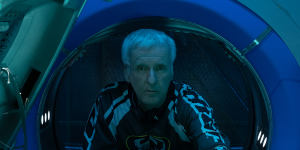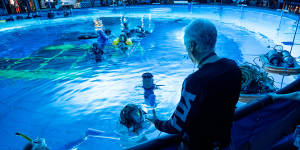Who knows what I was expecting – the T-1000,perhaps – but dressed in tan pants and a blue button-up,cleanly shaven and neatly grey,Cameron,68,is ridiculously unassuming. He looks like a fro-yo start-up’s angel investor. He looks like the smartest guy in middle management.
Which is a coincidence because,when I sat down with him in early September,he was in town for a speaking gig on behalf of some corporate types,teaching the leadership lessons he’s learned across four decades in the film industry,in the jet propulsion laboratory projects he’s worked on for NASA,and in his deep-sea exploration activities. You may have heard:in March 2012,Cameron famously became the first solo human to reach the bottom of the Challenger Deep,the deepest point of the Mariana Trench,where he spent almost four hours exploring the ocean floor at a depth of 11 kilometres. Why?
“See,a kid would never ask that,” Cameron scolds me.

Director James Cameron behind the scenes on Avatar:The Way of Water.Mark Fellman/20th Century Studios
The trip to Australia isn’t so far these days,ever since the Canadian filmmaker made New Zealand his permanent home two-and-a-half years ago. Back in 2011,with partner Suzy Amis (his fifth wife),he bought a dairy farm in the Wairarapa Valley,“threw out all the cows because we’re vegan”,and turned it into what’s now New Zealand’s largest producer of organic brassica. “That’s broccoli,cauliflower,chard,kale,” Cameron explains. “In New Zealand we’re a big fish in a small pond because the organic vegetable market is not so big there. Anyway,that’s our thing.”
I could talk vegetables for hours,but I’ve been gifted time with Cameron to discussAvatar:The Way of Water,the sequel to his groundbreaking 2009 mega-hit that introduced the world to Pandora and its blue-skinned inhabitants,the Na’vi. Globally,the originalAvatar remains the highest-grossing film of all time,with box office receipts of over US$2.9 billion. In Australia,it’s also an all-time box office No.1,earning just shy of $116 million across its lifetime.
Even just days ahead of its world premiere in London on December 6,the film’s still copping some finishing touches so no one’s seen it yet,bar a few extended 3D scenes that I’m legally unable to discuss. Still,much has been made of Cameron’s zealous plans with the franchise,pursuing four sequels that will see audiences getting a newAvatar movie roughly every two years through to 2028. It’s ambitious,if not excessive. And yet,there’s some sense in the madness.
Once a familiar threat returns to finish what was previously started,Jake Sully must work with Neytiri and the army of the Na'vi race to protect their planet.
For starters,revisiting the original film I was struck by its thematic heft:its anti-colonial message,its reverence towards Indigenous knowledge and the Indigenous relationship to nature and family. The heroes of the film are the native Na’vi with their complex connection to the land;the villains are war-hungry,resource-stealing American imperialists,sensitive to nothing but insatiable greed. All this,in a multiplex blockbuster!
More practically,the franchise lets Cameron play with his love of advanced film technology,sci-fi futurism,and adventu-neering (eg:in order to filmThe Way of Water’s extended underwater scenes,the cast had to learn how to free-dive;somehow,Kate Winslet can now hold her breath underwater for more than seven minutes). Basically,Avatar is Cameron’s ultimate sandbox,allowing him to engage with all his keenest preoccupations.
“Everything I need to say as a filmmaker,I can say within the films that I’ve already got mapped out,” Cameron says. “I spent about three years on the scripts. Tolkien took what,12 years to write his trilogy? The first thing I did on day one with the writers was I slapped down 800 pages of notes and said,‘Here’s the world,the culture,the characters,the basic story arc. Now,let’s figure it out’.”

Cameron filmed actors in a 245,000 gallon (927,000 litres) tank to recreate Pandora’s underwater world.Mark Fellman/20th Century Studios
Besides criticism of its “white saviour” dynamics,prioritising Jake Sully’s (Sam Worthington) storyline in the Na’vis’ resistance heroics (diverse casting was still seen more as a box office threat than an asset in 2009),I don’t remember the original film being especially controversial when it came out,right in the midst of George W.’s “war on terrorism”. But Cameron notes there was “a little bit of pushback from laissez-faire capitalists and conservatives” around its release. With the political divide now more polemical,is he anxious about potential backlash this time around?
“I’m sure that drumbeat will be much louder this time,” says Cameron. “But look,as a filmmaker I’m an artist and if an artist is not speaking their mind,then what the hell are they? It’s no secret that I’m an environmental activist and that I believe in sustainability – I believe we’re progressing,although not as fast as I would like to see. But theAvatar movies,they’re about people. They’re not didactic,they’re not preachy,they’re not particularly political. But if you want to look at it through that lens you can and it does make a statement about our relationship to the natural world and our relationship to Indigenous culture.

(L-R):Jake Sully (Sam Worthington),Ronal (Kate Winslet),and Tonowari (Cliff Curtis).20th Century Studios
“I call it the battle between the takers and the caretakers,” Cameron adds. “The Indigenous,our best representatives,have a caretaker mentality with respect to nature. For us to survive as a civilisation we have to take the best of what we’ve created in terms of technology and our knowledge base,but evolve into caretakers which we,as a collective,are not. The films are about that,but they’re not. It’s more between the lines,a feeling that you emerge with from the theatre.”
The journey to anotherAvatar film was itself unexpected for Cameron. He says that in 2012,in the midst of his foray to the Challenger Deep,the idea of returning to filmmaking was “the furthest thing from my mind”.
“You’ve got to understand,I couldn’t decide whether I wanted to be a writer or a scientist,right? I studied physics in college. I love engineering. I love marine biology. I was happy as Larry for eight years not working on any movie,just doing expeditions,” he says. “Even before I startedAvatar,the first one,I debated ever making another movie because that was such a seductive life to be leading.”

Cameron with Worthington,behind the scenes on the shoot. “He’s in the trench with you,” says Worthington of the director.Mark Fellman/20th Century Studios
It was the possibility of makingAvatar that lured him back to filmmaking. “I remember the head of 20th Century Fox at the time,Peter Chernin,saying to me,‘Well,it’s a solid script,we like it. Is there any way you can take out the hippie tree-hugger stuff?’ I said,‘Well,Peter,this meeting may be done because the hippie tree-hugger stuff is exactly why I’m making the movie and if you don’t want to make that movie,let’s not even start.’ And so they ultimately passed on the film,but then they came back and said,‘Okay,we’ve decided we want to make it’.”
New Zealand actor Cliff Curtis,who joins the franchise inThe Way of Water playing Tonowari,a rival Na’vi leader,says he’s grown ever fascinated by Cameron the closer they’ve worked.
“He told me once that he had a lucid dreaming experience when he was about 12 because he used to read a lot,and he dreamed up this image and painted it and it’s the firstAvatar poster,of the character Neytiri (played by Zoe Saldana). That world came fully formed to him in a dream. Now,you couldn’t get somebody more pragmatic or practical – he’s not a woo woo wah wah kind of guy – but in my culture,that’s shamanism,” Curtis laughs. “He has a vision at the age of 12,he builds his abilities to the point that he can realise that vision through his art in the discipline of filmmaking,and he’s made it real for us. That’s a shaman.”

(L-R):Neytiri (Zoe Saldana) and Jake Sully (Worthington).20th Century Studios
“The thing about Jim,” adds Australian actor Sam Worthington,who remains the centre of the sequel despite its new generational focus,“is you want to commit to his world. Because he’s not just up on the hill barking orders at you,he’s in the trench with you.”
At this stage,with filming on two sequels already in the bag,Cameron’s anxiety around the project is external. He has the story he wants to tell,mapped out across four films. But he’s not sure he’ll get the chance to tell it as he envisions.
“Sitting here today,I can’t tell you that,” he says. “Because it’s a market-driven thing,right? If we don’t succeed withAvatar 2,we’re not going to get to four or five.”
Let’s sayThe Way of Water,with its reported $US250 million budget,bombs or the audience appetite is just not there. What happens then?
“I doubt very much it’s going to bomb,but there are levels of success that may or may not make it a profitable enterprise. We’ll sort that out with Disney and we’ll decide to go forward or not,” Cameron says. He says the franchise is essentially “stuck in the cinema realm” and wouldn’t work in another medium because of its massive scale. “We can’t really do a TV spin-off like,say,The Mandalorian;we can’t cut to a close-up because the close-up is as expensive as a shot with 40,000 people in it.”
At the risk of understating it,his films are a lot. Does Cameron ever feel like just bashing out a three-week shoot on an indie budget,just getting a movie done and getting it out?
“Look,the days I love the best,whether it’s onAvatar or any of my films,are the days where I’m hand-holding the camera and it’s just me and an actor and we’re moving quickly,guerilla-style. I love that stuff and I get to do it. Just because I’m making a big film doesn’t mean there aren’t scenes within it that are shot as if it was a character story. I have those days and I find those days very satisfying. But I don’t have to make a whole film like that. It’s not the highest and best use of my skill set. I make epic movies. It’s what I do. And I love doing it.”
Avatar:The Way of Water opens in cinemas on December 15.
To read more from Spectrum,.
A cultural guide to going out and loving your city..
In case you missed it:the culture stories that start conversations
For decades depictions of sex in Hollywood have studiously avoided focussing on a woman’s actual sexual desires and pleasure. That is,until this year.
Mildura,six hours drive north-west from Melbourne,is used to being overlooked. So,why did US band choose this town – better known for its production of citrus fruits – to be the kick-off of their Australian tour? And how long did it take locals to realise this was not a practical joke?
Sunkissed,behind aviator shades,on a yacht with the Italian coastline behind,is too handsome to play Prince Charles in the fifth season of The Crown? Fans definitely think so.